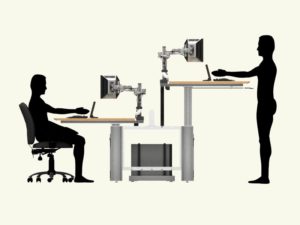Prolonged sitting is very prevalent – more than half of the working population’s 15 hours waking day is sedentary according to Massey University Professor of Ergonomics Stephen Legg and research student and physiotherapist Jane Pierce 
It has been linked to serious health effects – diabetes, cardiovascular disease, possible cancer and obesity to name but a few.
This in turn has led to various scaremongering headlines over the years including:
- Prolonged bouts of sitting are a killer, not just lack of exercise alone – British Journal of Sports Medicine, 19 January 2010
- Is Sitting a Lethal Activity – New York Times, 14 April 2011
- The Dangers of Sitting at Work – and Standing – Time Magazine, 13 April 2011
- Sitting all day is deadly – Bizshift 2013
- Do you have Sitting Disease? Take a Stand! –www.computingcomfort.org, 16 May 2013
- Sitting will kill you, even if you exercise – CNN, 2015
These headlines beg the question – are there benefits in standing? It’s an extremely pertinent query given that one study found that 50 per cent of the UK workforce is vulnerable to health problems related to prolonged standing.
This isn’t surprising, since prolonged standing is associated with low back pain, varicose veins, pregnancy issues, lower limb discomfort, plantar fasciitis and cramping.
Stand and deliver
Standing desks are proposed as a healthy alternative to sitting all day but the current evidence in support of their use is mixed to say the least:
- productivity – increasing evidence on improved cognition and output
- increased performance – mainly subjective
- weight loss – poor evidence, high inference
- leg swelling – minimal
- health – growing evidence, high inference
- compliance and discomfort – inconclusive
- increased standing – of course yes.
Misconceptions about standing desks include “they’re just a fad, “you have to stand all day”, “they only provide short-term results and people end up sitting most of the day anyway”, “they’re not private” and “they’re expensive”.
Yet even as long ago as the 17th century Italian physician Bernadino Ramazzini recommended that “prolonged static postures must be interrupted by movement”.
More recently, a 2001 study by Waterloo University Professors Jack Callaghan and Stuart McGill found that “standing appears to be a good rest from sitting given the reduction in passive tissue forces.
“However, the constant loading with little dynamic movement which characterizes both standing and sitting would provide little rest/change for muscular activation levels or low back loading.”
Increasing evidence such as this has led to numerous national and regional campaigns urging workers to get up and move regularly, including the Heart Foundation – Stand up for your health; the US – Take a Stand; Australia – Stand up Australia and Australia – Stand up, sit less, move more; and the UK – Sit less, Get Active.
Perhaps the best and most sensible common-sense recommendations are the Dutch ergonomic guidelines, which define the daily ‘safe zone’ as prolonged standing of less than one hour and a total day stand of less than four hours.
Various ideas have been put forward to mitigate the effects of prolonged standing including mats, compression stockings, shoe inserts and activity workstations, but it’s fair to say none have completely solved the problem.
Recent evidence-based recommendations include:
- two hours of predominantly desk-based occupations increasing to four hours a day of standing and light activity during working hours (prorated to part-time hours)
- regularly breaking seated work with standing work
- using adjustable-height desks (AHDs)
- taking standing or walking breaks.
Standing, walking and desk-based cycling have also been suggested but the long-term feasibility and extent to which these alternatives can be used is yet to be determined.
Plus, this type of ‘active’ sitting provides little cardio-metabolic benefit – though it may provide some musculoskeletal benefit.
Another way is active commuting, ‘being active’ during non-productive breaks at work, and substitution of work and non-work sitting tasks with standing and moving tasks throughout the day.
Time tasks
Whatever the choice, postures should be changed regularly and current evidence-based guidelines suggest that sedentary task bouts should be no longer than 20-30 minutes to obtain musculoskeletal and metabolic benefits.
Managers and workers should also use task variation to interrupt prolonged sitting by substituting sitting with a non-sedentary task or a brief non-sedentary activity,
For example:
- using a standing or walking workstation for computer work
- standing to read a document
- holding meetings standing
- walking with friends at lunchtime
- standing for some of the public transport work commute
- standing to talk on the phone
- walking to deliver a message to a colleague rather than emailing
- walking to get a drink or visit the bathroom.
Good job design can use substitution and interruption to minimise the harm from excessive occupational sitting.
Studies have found interventions targeting multiple aspects of the office work system are likely to be more effective than those targeting just a single aspect.
Successful and sustainable interventions include:
- participative approaches that engage workers
- creating social and physical environments to support/facilitate less sitting
- communication about the purpose and evidence for the intervention to employees
- champions to support the intervention
Proactive interventions such as these can reduce office sitting exposure by over an hour each workday – although more research is needed on other sedentary occupations such as drivers.
Ultimately, however, the biggest barrier to change is management concern about productivity. An MPhil (Sci) (Ergonomics) thesis by physiotherapist Jane Pierce entitled “The effects of introducing adjustable height desks in an office setting on workplace and leisure physical activity levels – a randomised control field trial” examined the efficacy of AHDs.
The 16-week study from July to November 2013 encompassed a medium-sized company in Hawkes Bay and involved 23 participants ranging in age from 22-58 years; 12 female and 11 male office workers employed 80 per cent full-time or more. Participants were randomly allocated into two groups.
The 11-strong control group of five women and six men used their own fixed-height desks, while the intervention group of seven women and five men were allocated electronic AHDs.
Both groups used pedometers to measure their steps and compiled fortnightly diaries summarising physical activity of sitting, standing or moving less than 1.5 metres or moving more than 1.5 metres from their desks.
They were also tasked with filling in pre- and post-questionnaires that asked qualitative questions about their physical activity.
The study produced some interesting results:
Step counts Average Standard Deviation
Control group 3988 3042
Intervention group 4287 3279
Activity levels
| Intervention
Male |
Intervention
Female |
Control
Male |
Control
Female |
|
| Walk >1.5m | ||||
| Weeks 1-2# | 26%
|
27%
|
15%
|
20%
|
| Weeks 3-8 | 35% | 28% | 14% | 19%
|
| Walk<1.5m | ||||
| Weeks 1-2# | 14%
|
5%
|
8%
|
7%
|
| Weeks 3-8 | 15% | 28% | 6% | 3%
|
| Stand | ||||
| Weeks 1-2# | 1%
|
1%
|
0
|
2%
|
| Weeks 3-8 | 33% | 15% | <1% | <1%
|
| Sit | ||||
| Weeks 1-2# | 60%
|
67% | 77%
|
72%
|
| Weeks 3-8 | 17% | 30% | 80% | 77%
|
Light physical activity clearly increased with AHDs, although reasons for gender differences in pattern of movement were inconclusive.
The intervention group reported increases of leisure activity alongside an increase in workplace activity, while there was no increase in subjective tiredness with increased activity at work.
The conclusion is clear – less sitting and more movement, be it at standing desks or taking regular breaks.




